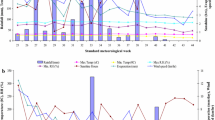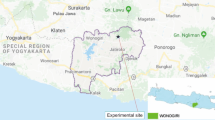Abstract
A field experiment using system of rice intensification (SRI) techniques was conducted in Chiba, Japan during the 2008 rice-growing season (May–September) with eight treatment combinations in a split–split plot design (S–SPD) to observe the potential of SRI methods under the temperate climatic conditions in Japan. Intermittent irrigation with alternate wetting and drying intervals (AWDI) and continuous flooding throughout the cropping season were the two main-plot factors, while the effects of age of seedlings and plant spacing were evaluated as sub and sub–sub plot factors, respectively. The experiment results revealed that the proposed AWDI can save a significant amount of irrigation water (28%) without reduced grain yield (7.4 t/h compared with 7.37 t/h from normal planting with ordinary water management). Water productivity was observed to be significantly higher in all combinations of practices in the intermittent irrigation plots: 1.74 g/l with SRI management and AWDI as compared to 1.23 g/l from normal planting methods with ordinary water management. In addition, the research outcomes showed a role of AWDI in minimizing pest and disease incidence, shortening the rice crop cycle, and also improving plant stand until harvest. Synergistic effects of younger seedlings and wider spacing were seen in tillering ability, panicle length, and number of filled grains that ultimately led to higher productivity with better grain quality. However, comparatively better crop growth and yields when using the same SRI practices with ordinary water management underscore a need for further investigations in defining what constitute optimum wetting and drying intervals considering local soil properties, prevailing climate, and critical watering stages in rice crop management.




Similar content being viewed by others
References
Anbumozhi V, Yamaji E, Tabuchi T (1998) Rice crop growth and yield as influenced by changes in ponding water depth, water regime and fertigation level. Agric Water Manag 37:241–253
Anthofer J (2004). Evaluation of the system of rice intensification (SRI) in Cambodia (Online). Report prepared for GTZ Phnom Penh. Available: http://www.tropentag.de/2004/abstracts/full/399.pdf. Retrieved 12 Jan 2009
Association-Tefy-Saina (1995) Couts de Revient Dans les Systmes de Riziculture Divers. Association Tefy Saina, National Workshop on SRI, Antananarivo
Barrett CB, Moser CM, McHugh OV, Barison J (2004) “Better technology, better plots or better farmers? Identifying changes in productivity and risk among Malagasy rice farmers”. Am J Agric Econ 86:869–888
Bhuiyan SI, Tuong TP (1995). Water use in rice production: Issues, research opportunities and policy implications. Paper presented at the Inter-Center Water Management Workshop, 29–30 September 1995. International Irrigation Management Institute, Colombo, and World Health Organization, Colombo
Chaboussou F (2004) Healthy crops: a new agricultural revolution. Jon Carpenter Publishing, Charnley, UK
Davids G (1998 Unpublished). Use of the capital intensive irrigation systems in rice. Davids Engineering, Inc. California, USA
Gani A, Rahman A, Rustam D, Hengsdijk H (2002) Water management experiments in Indonesia. Paper presented in international symposium on water wise rice production, IARI, New Delhi, November 2–3, pp 29–37
Guerra LC, Bhuiyan SI, Tuong TP, Barker R (1998). Producing more rice with less water from irrigated systems. SWIM Paper 5. International Irrigation Management Institute, Colombo
Hatta S (1967) Water consumption in paddy field and water saving rice culture in the tropical zone. Jpn Trop Agric 11:106–112
Horie T, Shiraiwa T, Homma K, Katsura K, Maeda S, Yoshida H (2005) Can yields of lowland rice resume the increases that they showed in the 1980s? Plant Prod Sci 8:257–272
IRRI (2008) Rice production, area and yield by country and geographical region-FAO. IRRI world rice statistics. Available: http://beta. irri.org/solutions/. Retrieved 18 Dec 2008
Jagannath B, Kamath KS, Chandrappa HM, Shadakshari YG, Thyagaraj NE (1998) Optimum seedlings per unit area for high yielding rice varieties in hill zone of Karnataka. IRRN 23:36–37
Kar S, Varade SB, Subramanyam TK, Ghildyal BP (1974) Nature and growth pattern of rice root system under submerged and unsaturated conditions. Il Riso 23:173–179
Keisuke S, Yamaji E, Sato S, Budhiharto PS, Mizoguchi M (2007) Sustainability of system of rice intensification: benefits of SRI focusing on effects of intermittent irrigation on yield increase and water savings. In: Proceeding of PAWEES 2007 6th international conference on sustainable rural development and management, Seoul National University, Seoul, 18 October 2007, pp 25–37
Krishna A, Biradarpatil NK, Channappagoudar BB (2008) Influence of system of rice intensification (SRI) cultivation on seed yield and quality. Karnataka J Agric Sci 21(3):369–372
Li XY, Xu XL, Li H (2005) A socioeconomic assessment of the system of rice intensification (SRI): a case study from Xinsheng Village, Jianyang County, Sichuan Province. Centre for Integrated Agricultural Development, China Agricultural University, Beijing
Mao Z (1993) Principle and technique of water saving irrigation for rice. Wuhan University of Hydraulic and Electric Engineering, Wuhan
Mao Z (1996) Environmental impact of water-saving irrigation for rice. In: Irrigation scheduling: from theory to practice. Proceedings of the ICID/FAO workshop on irrigation scheduling, Rome. FAO, Rome, 12–13 September 1995
Rajesh V, Thanunathan K (2003) Effect of seedling age, number and spacing on yield and nutrient uptake of traditional kambanchamba rice. Madras Agric J 90:47–49
Rakotomalala HW (1997) Comparison entre la Riziculture Traditionnelle et le Systeme de Riziculture Intensive dans La Region de Ranomafana. Science Agronomique, Universite d’Antananarivo, Antananarivo
Sato S, Uphoff N (2007). A review of on-farm evaluation of system of rice intensification (SRI) methods in eastern Indonesia. CAB reviews: perspectives in agriculture, veterinary science, nutrition and natural resources. Commonwealth Agricultural Bureau International, Wallingford, UK
Senthilkumar K (2002) Productivity of hybrid rice under water saving irrigation and in situ weed incorporation. M.Sc. (Ag.) Thesis submitted to Tamil Nadu Agricultural University, Coimbatore
Shrirame MD, Rajgire HJ, Rajgire AH (2000) Effect of spacing and seedling number per hill on growth attributes and yield of rice hybrids under lowland condition. J Soils Crops 10:109–113
Singh CB, Aujla TS, Sandhu BS, Khera KL (1996) Effects of transplanting data and irrigation regime on growth, yield and water use in rice (Oryza sativa) in northern India. Indian J Agric Sci 66:137–141
Sinha SK, Talati J (2007) Productivity impacts of the System of Rice Intensification (SRI): a case study in West Bengal, India. Agric Water Manag 87:55–60
Stoop WA, Uphoff N, Kassam A (2002) A review of agricultural research raised by the system of rice intensification (SRI) from Madagascar: opportunities for improving farming systems for resource-poor farmers. Agric Syst 71:249–274
Tabbal DF, Lampayan RM, Bhuiyan SI (1992). Water-efficient irrigation technique for rice. In: Murty VVN, Koga K (ed) Soil and water engineering for paddy field management. Proceedings of the international workshop on soil and water engineering for paddy field management. Asian Institute of Technology, Bangkok, 28–30 January
Udyakumar (2005) Studies on system of rice intensification (SRI) for seed yield and seed quality. M.Sc. (Agri.) Thesis, Acharya N.G. Ranga Agricultural University, Hyderabad (India)
Uphoff N (2007) The system of rice intensification: using alternative cultural practices to increase rice production and profitability from existing yield potentials. International Rice Commission Newsletter, Number 55, UN. Food and Agriculture Organization, Rome
Van der Hoek W, Sakthivadivel R, Renshaw M, Silver JB, Birley MH, Konradsen F (2001). Alternate wet/dry irrigation in rice cultivation: a practical way to save water and control malaria and Japanese encephalitis? Research Report 47. International Water Management Institute, Colombo
Vijayakumar M, Ramesh S, Chandrasekaran B, Thiyagarajan TM (2001) Effects of system of rice intensification (SRI) practices on yield attributes, yield and water productivity of rice (Oryza sativa l.). Res J Agric Biol Sci 2(6):236–242
Author information
Authors and Affiliations
Corresponding author
Rights and permissions
About this article
Cite this article
Chapagain, T., Yamaji, E. The effects of irrigation method, age of seedling and spacing on crop performance, productivity and water-wise rice production in Japan. Paddy Water Environ 8, 81–90 (2010). https://doi.org/10.1007/s10333-009-0187-5
Received:
Accepted:
Published:
Issue Date:
DOI: https://doi.org/10.1007/s10333-009-0187-5




